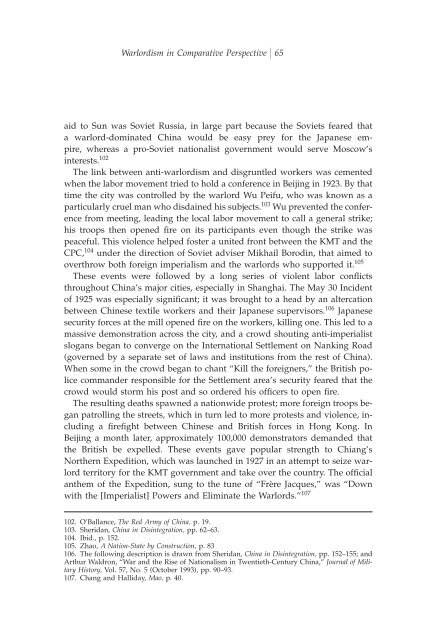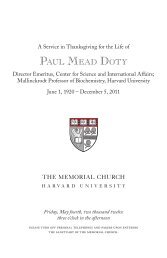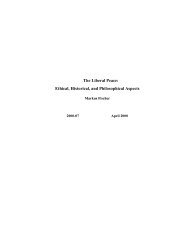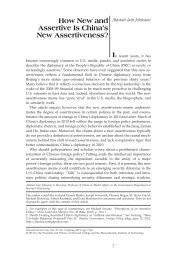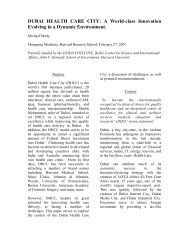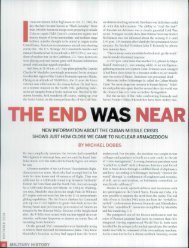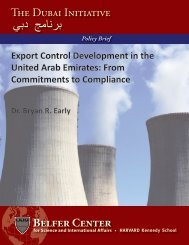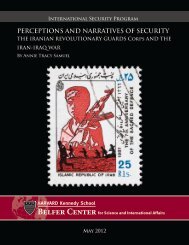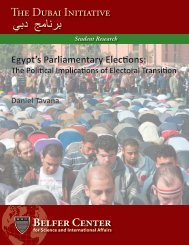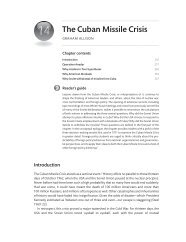Warlordism in Comparative Perspective - MIT Press Journals
Warlordism in Comparative Perspective - MIT Press Journals
Warlordism in Comparative Perspective - MIT Press Journals
Create successful ePaper yourself
Turn your PDF publications into a flip-book with our unique Google optimized e-Paper software.
<strong>Warlordism</strong> <strong>in</strong> <strong>Comparative</strong> <strong>Perspective</strong> 65<br />
aid to Sun was Soviet Russia, <strong>in</strong> large part because the Soviets feared that<br />
a warlord-dom<strong>in</strong>ated Ch<strong>in</strong>a would be easy prey for the Japanese empire,<br />
whereas a pro-Soviet nationalist government would serve Moscow’s<br />
<strong>in</strong>terests. 102<br />
The l<strong>in</strong>k between anti-warlordism and disgruntled workers was cemented<br />
when the labor movement tried to hold a conference <strong>in</strong> Beij<strong>in</strong>g <strong>in</strong> 1923. By that<br />
time the city was controlled by the warlord Wu Peifu, who was known as a<br />
particularly cruel man who disda<strong>in</strong>ed his subjects. 103 Wu prevented the conference<br />
from meet<strong>in</strong>g, lead<strong>in</strong>g the local labor movement to call a general strike;<br />
his troops then opened ªre on its participants even though the strike was<br />
peaceful. This violence helped foster a united front between the KMT and the<br />
CPC, 104 under the direction of Soviet adviser Mikhail Borod<strong>in</strong>, that aimed to<br />
overthrow both foreign imperialism and the warlords who supported it. 105<br />
These events were followed by a long series of violent labor conºicts<br />
throughout Ch<strong>in</strong>a’s major cities, especially <strong>in</strong> Shanghai. The May 30 Incident<br />
of 1925 was especially signiªcant; it was brought to a head by an altercation<br />
between Ch<strong>in</strong>ese textile workers and their Japanese supervisors. 106 Japanese<br />
security forces at the mill opened ªre on the workers, kill<strong>in</strong>g one. This led to a<br />
massive demonstration across the city, and a crowd shout<strong>in</strong>g anti-imperialist<br />
slogans began to converge on the International Settlement on Nank<strong>in</strong>g Road<br />
(governed by a separate set of laws and <strong>in</strong>stitutions from the rest of Ch<strong>in</strong>a).<br />
When some <strong>in</strong> the crowd began to chant “Kill the foreigners,” the British police<br />
commander responsible for the Settlement area’s security feared that the<br />
crowd would storm his post and so ordered his ofªcers to open ªre.<br />
The result<strong>in</strong>g deaths spawned a nationwide protest; more foreign troops began<br />
patroll<strong>in</strong>g the streets, which <strong>in</strong> turn led to more protests and violence, <strong>in</strong>clud<strong>in</strong>g<br />
a ªreªght between Ch<strong>in</strong>ese and British forces <strong>in</strong> Hong Kong. In<br />
Beij<strong>in</strong>g a month later, approximately 100,000 demonstrators demanded that<br />
the British be expelled. These events gave popular strength to Chiang’s<br />
Northern Expedition, which was launched <strong>in</strong> 1927 <strong>in</strong> an attempt to seize warlord<br />
territory for the KMT government and take over the country. The ofªcial<br />
anthem of the Expedition, sung to the tune of “Frère Jacques,” was “Down<br />
with the [Imperialist] Powers and Elim<strong>in</strong>ate the Warlords.” 107<br />
102. O’Ballance, The Red Army of Ch<strong>in</strong>a, p. 19.<br />
103. Sheridan, Ch<strong>in</strong>a <strong>in</strong> Dis<strong>in</strong>tegration, pp. 62–63.<br />
104. Ibid., p. 152.<br />
105. Zhao, A Nation-State by Construction, p. 83<br />
106. The follow<strong>in</strong>g description is drawn from Sheridan, Ch<strong>in</strong>a <strong>in</strong> Dis<strong>in</strong>tegration, pp. 152–155; and<br />
Arthur Waldron, “War and the Rise of Nationalism <strong>in</strong> Twentieth-Century Ch<strong>in</strong>a,” Journal of Military<br />
History, Vol. 57, No. 5 (October 1993), pp. 90–93.<br />
107. Chang and Halliday, Mao, p. 40.


